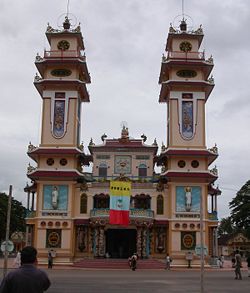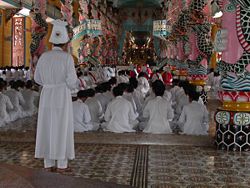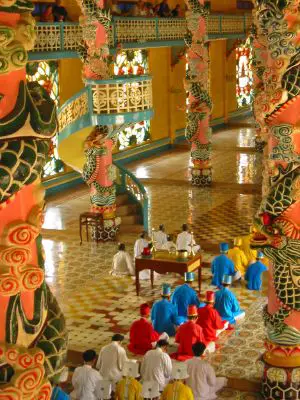Cao Dai
Cao Dai (Cao Đài) is a relatively new, syncretist, monotheistic religion, officially established in Tây Ninh, southern Vietnam, in 1926. Đạo Cao Đài is the religion's shortened name, the full name is Đại Đạo Tam Kỳ Phổ Độ (Great Religion [of The] Third Period [of] Revelation [and] Salvation).
The term Cao Đài literally means "high tower" or "palace". Figuratively, it means that highest place where God reigns, adopted from popular Vietnamese Taoist usage. It is also the abbreviated name for God, the creator of the universe, whose full title is Cao Đài Tiên Ông Đại Bồ Tát Ma-ha-tát.
Caodaiists credit God as the religion's founder. They believe the teachings, symbolism and organization were communicated directly from Đức (means Venerable) Cao Đài. Even the construction of the Tây Ninh Holy See is claimed to have had divine guidance.
Adherents engage in ethical practices such as prayer, veneration of ancestors, nonviolence, and vegetarianism with the goal of rejoining God the Father in Heaven and the ultimate goal of freedom from the cycle of birth and death.
Estimates of the number of Cao Đài adherents in Vietnam vary, but most sources give two to three million. Some estimates are as high as eight million adherents in Vietnam. An additional 30,000 (primarily ethnic Vietnamese) in the United States, Europe, and Australia. [1]
History
Founding
Cao Đài's first disciple was Ngô Văn Chiêu (1878-1932), a Vietnamese man working for French colonialists. He was well versed in both Western and Eastern spiritual traditions, and in 1919 began participating in séances with collegues. They claimed to have received direct communications from Cao Dai, who gave them explicit instructions for establishing a new religion that would commence the Third Era of Religious Amnesty.
Development
Cao Dai grew rapidly in the decade following its establishment as a church in 1926. The movement was and remains especially popular in Southern Vietnam. Leading up to the unification of Vietnam in 1975 the Cao Dai Holy See was a powerful force in religion and politics in the South, controlling great amounts of property, claiming many adherents, and organizing its own military resistence. However, following unification under the communist government Cao Dai lost a great deal of its power, though retaining its temples and a great deal of followers.
Beliefs
Cao Dai, being syncretic, holds beliefs common in other faith traditions, such as: karma, reincarnation, the unity of God, the existence of the soul, and ancestor veneration. Traditional Vietnamese cultural ideas and taboos are also incorporated into the belief structure of Cao Dai.
God
Before God existed, there was the Tao - that nameless, formless, unchanging, eternal source referenced in the Tao Te Ching. At some point, a cosmic event occurred, out of which God was born. The universe could not yet be formed, for God controlled only Yang. Therefore, He shed a part of himself and created the Goddess, master of Yin. In the presence of Yin and Yang, the universe materialized. The Goddess is, literally, the mother of the myriad of things in the Universe. Thus, Caodaiists not only worship God, the father, but also the Goddess, literally referred to as the Mother Buddha. Note that the Goddess, or Mother Buddha, is male, as are all Buddhas. The Goddess is master over Yin but is not a part of Yin, which is female. However, Caodaiists consider themselves strict monotheists. In the Cao Dai understanding of God we see influences from Taoism, Buddhism, and Western monotheistic tradition. Cao Dai understanding of Yin and Yang is similar to traditional Asian understandings, in that the two components are opposing in nature but not purpose, and are equal.
Worship
Caodaiists perform prayer and reverence to God. Prayer ceremonies are held in temples at 6 A.M., noon, 6 P.M., and midnight daily. Offerings of incense, tea and food are made on the altar, just as is performed in traditional Chinese and Vietnamese Buddhism and Taoism. Though men and women are viewed as equal in Cao Dai, when entering the temple for a service men enter from the right and women enter from the left.
Séances
Critical in the formation of Cao Dai were [[séances], through which information about God was received. Séances in Cao Dai continue to form the canon of revealed material in the religion, though regulated by the Holy See. The manner in which séances are conducted are not limited; at times, spirit writing using a brush or other writing implement are used. Alternatively, blank sheets of paper can be placed in an envelope and left above the altar until they are taken down and revealed to hold a new message. Séances can be conducted in Vietnamese, Chinese, French, and English, depending on the spirit being contacted.
Syncretism and Periods of Religious Thought
Cao Dai recognizes the diversity of religious history in both the East and West, and moves to include them within the Cao Dai religion. The efficacy of Buddhism, Chinese religions, and the monotheistic Abrahamic faiths is acknowledged, though in a hierarchal manner. These movements are called the Three Teachings, known as the Teachings of the Buddhas, the Teachings of the Sages, and the Teachings of the Saints. The Three Teachings represent levels of spiritual attainment, with the Teachings of the Buddhas as the highest. In addition to Buddhas, Sages, and Saints Cao Dai also recognizes Thần, for which there is no English translation. Thần, Saints and Sages may have extremely long life in the realms of heaven, but only Buddhas are free from the cycle of birth and death.
In recognizing the Three Teachings Cao Dai also recognizes three periods of spiritual revelation from God. The first and most ancient period includes figures such as Laozi, Dipankara Buddha, and legendary Chinese sages. The second period includes Shakyamuni Buddha, Muhammad, Confucius, Jesus, and Moses. Caodaiists believe that though the truths revealed by these figures was received from God it was limited to their geographical and historical context, and was distorted in time. The Cao Dai religion asserts we are presently in the third age of revelation and salvation, with a direct link to God through the Cao Dai movement.
Although various sects of Caodaiism claim to have received messages from numerous spiritual entities, the Tây Ninh Holy See acknowledges significantly fewer. Inside the Holy See is a painting depicting the Three Saints [2] signing a covenant between God and mankind. From left to right, they are: Sun Yat Sen (a Chinese revolutionary and leader), Victor Hugo (a French author and poet) and Nguyễn Bỉnh Khiêm (a Vietnamese poet). Other famous Western figure are both honored and contacted through séance in Cao Dai, including Joan of Arc, Shakespeare and Vladimir Ilich Lenin.
Symbols
God is symbolized by the Divine Eye, specifically the left eye because Yang is the left side and God is the master of Yang. The Divine Eye is widely displayed throughout Cao Dai temples and literature. This symbol was revealed to Ngô Văn Chiêu directly during a séance.
Scriptures
The Tây Ninh Holy See recognizes three main scriptures:
- 1. Thánh Ngôn Hiệp Tuyển
- 2. Pháp Chánh Truyền (The Religious Constitution of Caodaiism)
- 3. Kinh Thiên Đạo Và Thế Đạo
- Note: Scriptures from other sects will be listed later.
Religious Constitution and Organization
Americans may be surprised to find that they are more familiar with Caodaiism's organizational structure than they realize. Caodaiism's governing body consists of three branches that are functionally equivalent to the U.S.'s legislative, executive and judicial branches.
The head of the Executive Branch is called "Giáo Tông," which means leader or head of a philosophical or religious organization. Similarities between the hierarchy of Caodaiism's dignitaries and those of the Roman Catholic Church have led translators to borrow terminologies such as pope, cardinals, bishops, priests, etc. In practice, Caodaiism has more ranks and titles of which there are no official English translation as of yet. The actual Vietnamese term for Pope, as in the Catholic Pope, is "Giáo Hoàng."
Caodaiism stresses equality among men and women. However, the fact that ordained women may attain ranks only up to cardinal but not Pope may be misconstrued as unfair bias. The reason was explained by God when He established the church's hierarchical order. Yang represents male and Yin corresponds to female. Yin cannot rule over Yang or else chaos would occur.
Splinter Groups
Caodaiism has also suffered from schisms like other religions. Some of the Cao Đài sects that have broken away from the Tây Ninh Holy See are Chiếu Minh, Bến Tre and Đà Nẵng.
Chiếu Minh - founded by Ngô Văn Chiêu. Mr. Chiêu refused his appointment as Caodaiism's first Pope and was neither involved in the religion's official establishment in 1926 nor the Tay Ninh Holy See. He accepted another entity as Đức Cao Đài and the Chiếu Minh sect of Caodaiism was formed.
External links
- Centre for Studies in Caodaiism, Sydney
- Tam Kỳ Nguyên Nguyên Bản Bản
- Cao Đài Overseas Missionary
- Cao Đài site
- Cao Đài
- PBS feature: Cao Đài
- Reporter Ron Gluckman's impression of Caodaiism
Credits
New World Encyclopedia writers and editors rewrote and completed the Wikipedia article in accordance with New World Encyclopedia standards. This article abides by terms of the Creative Commons CC-by-sa 3.0 License (CC-by-sa), which may be used and disseminated with proper attribution. Credit is due under the terms of this license that can reference both the New World Encyclopedia contributors and the selfless volunteer contributors of the Wikimedia Foundation. To cite this article click here for a list of acceptable citing formats.The history of earlier contributions by wikipedians is accessible to researchers here:
The history of this article since it was imported to New World Encyclopedia:
Note: Some restrictions may apply to use of individual images which are separately licensed.


